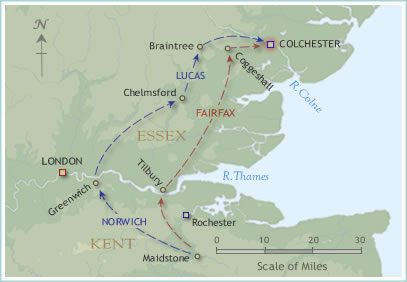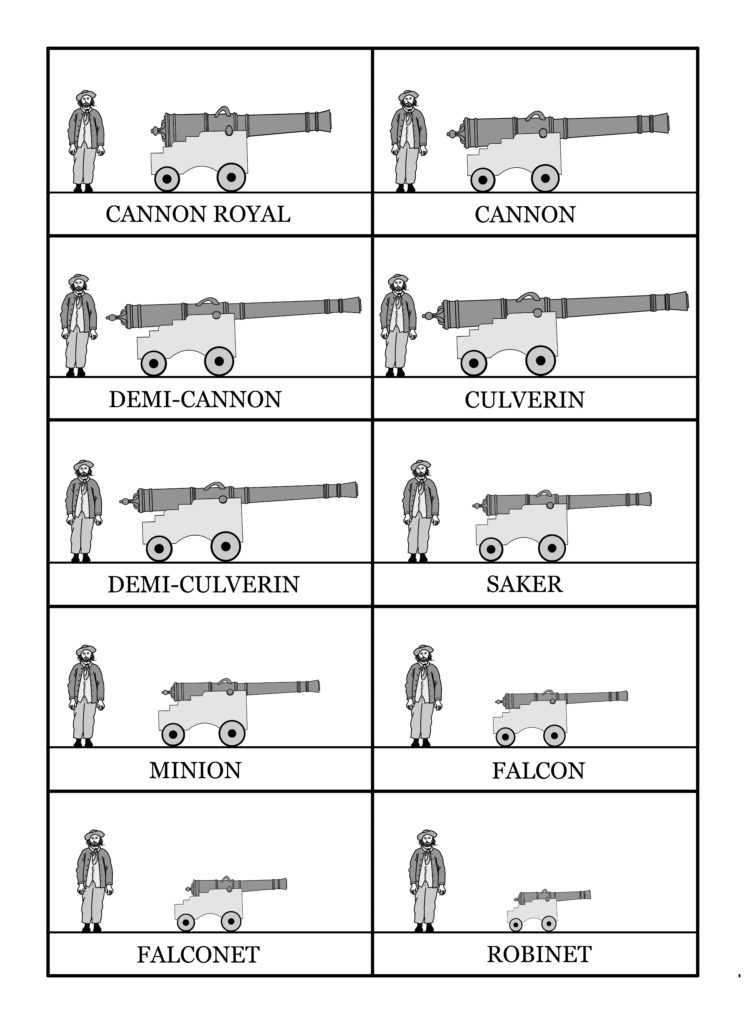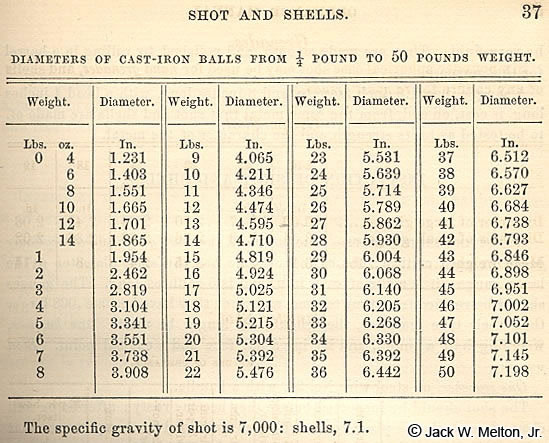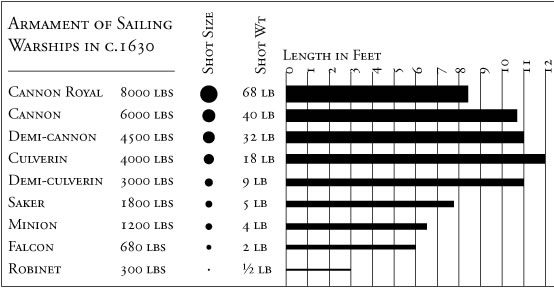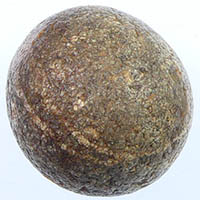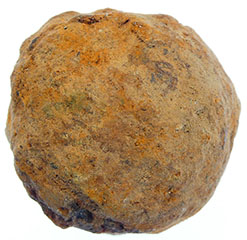

Metal detecting holidays in England with the World's most successful metal detecting club.20 years plus.
Twinned with Midwest Historical Research Society USA.
Cannon balls - stone and metal |
We find a large and diverse caliber range of musket balls being next to a major site of the English civil wars. We have also found both stone and metal cannon balls.
Siege of Colchester, Essex, 13 Jun-27 Aug 1648
Lucas deployed his forces to occupy the suburbs and bar the approach road from London into Colchester. Fairfax hoped to repeat his achievement at Maidstone and ordered an immediate attack. The Royalists resisted fiercely. Barkstead's infantry were thrown back three times, but the superior Parliamentarian horse overwhelmed the Royalists and the entire force was pushed back through the suburbs of Colchester towards the main town. Barkstead led the pursuit and advanced through the town gates only to be routed by a sudden cavalry charge and flank attack by Royalist infantry. Fairfax continued the assault until midnight, but was finally forced to abandon the attempt to carry Colchester by storm, having lost between 500 and 1,000 men. Colchester was strongly fortified. Fairfax resigned himself to committing his forces to a long siege despite the threat from the Scots and Langdale's Royalists in the north of England. Roads leading to Colchester were secured against the possibility of the Royalists breaking out and Parliamentarian warships blockaded the mouth of the River Colne to prevent supplies being shipped in. All through June, the Parliamentarians worked on constructing a ring of forts around the perimeter of the town where siege guns were mounted to batter the walls. On 2 July the circumvallation of Colchester was completed. On 14 July Fairfax's troops seized the Hythe, Colchester's harbour on the Colne. The following day the gatehouse of the old abbey which commanded the southern wall of the town was taken. The siege grew bitter and brutal. Uncharacteristically, Fairfax's troops committed a number of atrocities, including the desecration of graves in the Lucas family vault and the torturing of a messenger boy. The civilians of Colchester were mostly Parliamentarian sympathisers but Fairfax refused to make any concessions to alleviate their suffering. On the other side, the Royalists were accused of using poisoned bullets, i.e. bullets roughened and then rolled in sand to increase the likelihood of causing gangrenous wounds. By the beginning of August, provisions in Colchester had almost run out and the defenders were starving. Lord Norwich and Sir Charles Lucas clung on with the sole intention of keeping a large contingent of the New Model Army pinned down at Colchester but on 24 August, news came of the defeat of Langdale and the Scots at the battle of Preston. Realising that their cause was lost, the Colchester Royalists began negotiations for surrender. Colchester siege diary [offsite] The Royalist Martyrs Colonel Farre managed to escape and Sir Bernard Gascoigne was reprieved because he was a foreign national, but the execution of Lucas and Lisle went ahead. Fairfax's decision — almost certainly influenced by Commissary-General Ireton — was controversial. Although the Royalist officers had surrendered on mercy, it was unprecedented in the civil wars for an execution to be carried out under such circumstances. Ireton and Fairfax justified the severity of the sentence on the grounds that Lucas and Lisle had caused unnecessary bloodshed by attempting to defend an untenable position. Furthermore, Lucas had broken his parole by going to war against Parliament a second time, and was himself accused of executing prisoners in cold blood during the siege. The executions reflect the sense of anger and frustration felt by Parliamentarians at the Royalists who had inflicted a second civil war upon the nation. They were calculated to deter others from taking up arms against Parliament and to set a precedent for the execution of Parliament's enemies. The executions of Lucas and Lisle were carried out in the evening of 28 August 1648 in Colchester Castle. They died courageously and were swiftly elevated to the status of Royalist martyrs. Pamphlets appeared within days condemning their barbarous murder by Fairfax. According to legend, the grass never again grew on the spot where they were killed. The area is now paved over and marked by a memorial obelisk.
Cannon balls English cannon saw its first use during the Hundred Years War, being used in small numbers during the 1340s. "Ribaldis" were first mentioned in the English Privy Wardrobe accounts during preparations for the Battle of Crécy between 1345 and 1346.These are believed to have shot large arrows and simplistic grapeshot, but they were so important they were directly controlled by the Royal Wardrobe.According to the contemporary poet Jean Froissart, the English cannon made "two or three discharges on the Genoese", which is taken to mean individual shots by two or three guns because of the time taken to reload such primitive artillery. Similar cannon appeared at the Siege of Calais later the same year and by the 1380s, the "ribaudekin" had become mounted on wheels. Towards the end of the Middle Ages, the development of cannon made revolutionary changes to siege warfare throughout Europe, with many castles becoming susceptible to artillery fire. In England, significant changes were evident from the 16th century, when Henry VIII began building Device Forts between 1539 and 1540 as artillery fortresses to counter the threat of invasion from France and Spain. They were built by the state at strategic points to form the first powerful cannon batteries, but, though they had many of the same architectural facets as true castles, they served a purely military function (rather than serving as residences).Deal Castle remains one of the most impressive such Device Forts, and was perfectly symmetrical, with a low, circular keep at its centre. Over 200 cannon and gun ports were set within the walls, and the fort formed a firing platform with a shape that allowed many lines of fire. In addition, its low curved bastions were designed to deflect cannonballs.Cannon were now an inexorable part of English warfare. Cannon also saw use in the Tudor navy (where a cannon was a "gun", and a cannonball a "shot"). The French "culverin" was adapted for naval use by the English in the late 16th century, and had a significant advantage over the ballista that had previously been used in naval warfare.This cannon was of relatively long barrel and light construction, and fired solid round shot projectiles at long ranges along a flat trajectory. One of the first ships to be able to fire a full cannon broadside was the English carrack the Mary Rose, built in Portsmouth from 1510–1512, and equipped with 78 guns (91 after an upgrade in the 1530s). It was one of the earliest purpose-built warships to serve in the English Navy (thought never to have served as a merchant ship), and her crew consisted of 200 sailors, 185 soldiers, and 30 gunners. With the Age of Discovery, rivalry developed between European colonies and the importance of cannon in naval warfare increased. Many merchant vessels were armed with cannon and the aggressive activities of English privateers, who engaged the galleons of the Spanish treasure fleets, helped provoke the first Anglo-Spanish War, though it was not one of the main factors.A fleet review on Elizabeth I's accession in 1559 showed the navy to consist of 39 ships and in 1588, Philip II of Spain launched the Spanish Armada against England. In a running battle lasting over a week, the Armada was scattered and defeated by the
Stone and lead Sling shot,Cannon balls
Stone canon balls, or shot, were made by hand by an experienced stonemason. The process was, and still is (can be made for living history demos but not fired ), a time consuming job. Material would have been any hard natural stone that was available, usually sand stone but sometimes granite. The stone would be hand worked to small radius sections and then rubbed up with a stone block. A reverse section template would be used for accuracy.
|
||
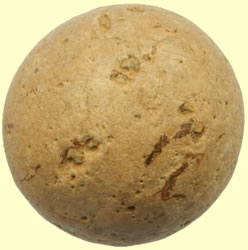 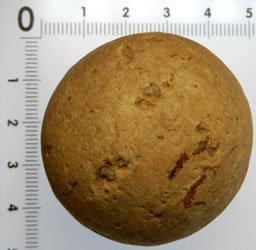 |
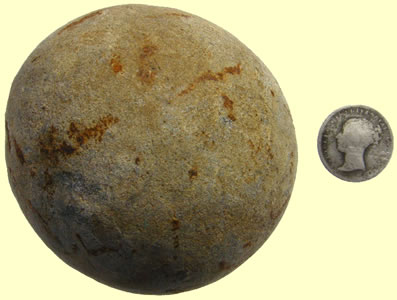 |
|
| 16thC stone cannon ball - 2 inch calibre | 16thC stone cannon ball next to Victorian sixpence | |
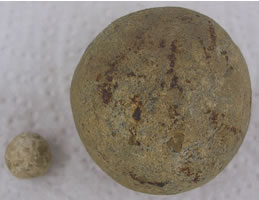 |
  |
|
| 16thC stone cannon ball next to a lead musket ball for size | 16thC stone cannon balls | |
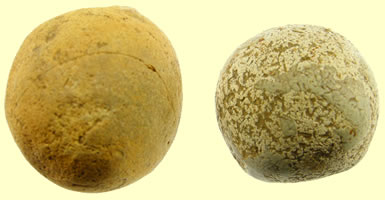 |
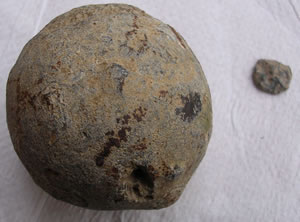 |
|
16thC stone cannon ball 0.42 inch, 45 Caliber next to a .493 inch Caronade type shell
|
16thC stone cannon ball next to a lead token | |
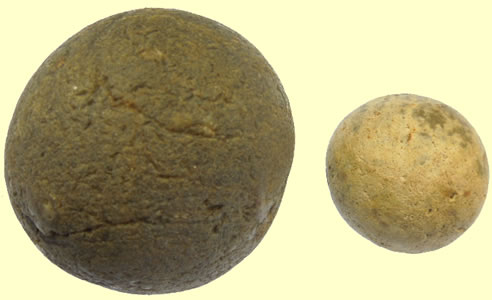 |
  |
|
| 16thC stone cannon ball - various calibres | ||
  |
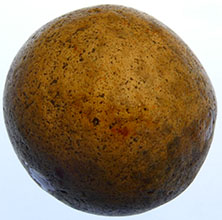 |
|
| 16thC stone cannon ball - probably gun type was a Minion | 16thC Stone cannon ball 43mm dia |
|
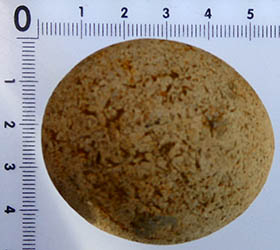 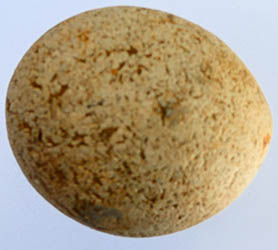 |
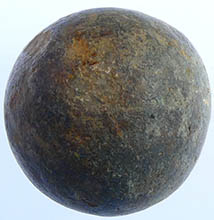 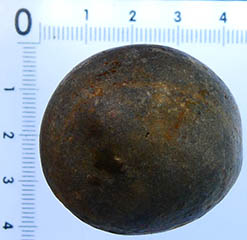 |
|
| Roman stone ballista shot | Stone cannon ball | |
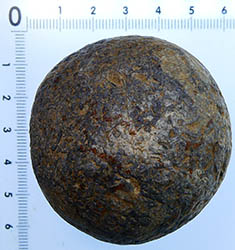 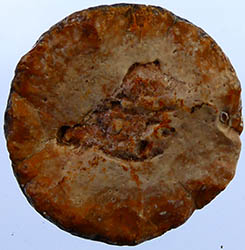 |
 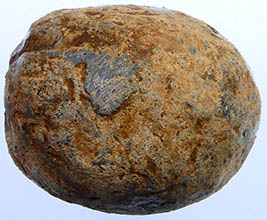 |
|
| 16th C stone cannon ball | Roman lead sling shot | |
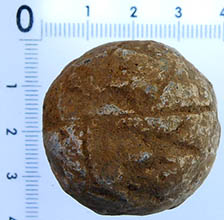 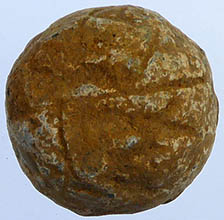 |
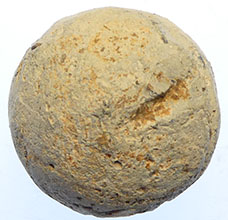 |
|
16thC lead cannon ball 34mm dia 5.5 oz |
16thC Lead 1/4 pounder cannon ball 103g,27mm dia |
|
 |
  |
|
| 16thC lead cannon ball | 16thC stone cannon ball | |
 |
 |
|
16th Stone cannon ball 16.7g, 23.2.mm dia |
Roman lead ballista shell | |
16th C stone cannon balls
16thC stone cannon ball 40.6 mm dia
16thC stone/ musket/cannon balls 5.1g,17.42mm 21g, 27.5mm 24g, 26.99m
Two 16thC stone cannon balls 45.3mm dia, 115g, 4oz and 59.3mm dia 29`g, 10oz
|
||
Metal Cannon balls Used from 1642-45 |
||
1640's English civil war cannon balls - 18 pounder sized - solid iron balls used in strands of grape 59mm dia, 1.96lbs - Falcon |
||
 |
  |
|
| 1640's Civil War cannon ball - 45mm dia- 336g, 11.9oz | 1640's Civil War half pound cannon ball - 7.8oz,39mm | |
 |
 |
|
| Cannon ball 15oz ( approx 1 pound, 1.9 inches dia) | 1640's English Civil War 3/4lb cannon ball - 1.5 inch dia | |
  |
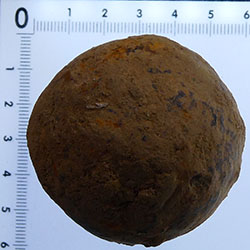 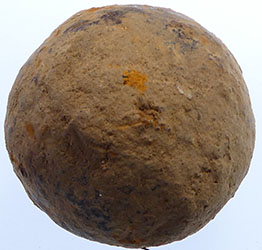 |
|
| 1640's English civil war 2 inch iron cannon ball | 1640's Civil war cannon ball 0.96 Lbs - 1 pounder 1.9 inches diameter - 48.5 mm |
|
|
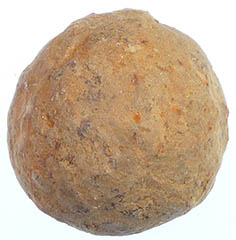 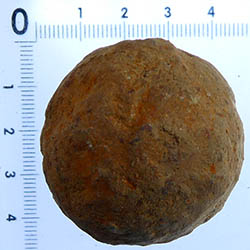 |
|
1640's Civil War cannon cast iron ball 3.8oz,33mm (1/4 lb) |
1640's Civi war cannon war - 8oz - half pounder - Robinet |
|
  |
 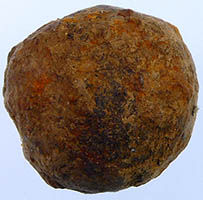 |
|
1640's Civil War Iron cannon ball 40mm dia, 211g, 7.45 oz - 1/2 pounder Robinet |
1640's Civil War Iron cannon ball 29mm 90g, 3.18oz- 1/4 pounder |
|
|
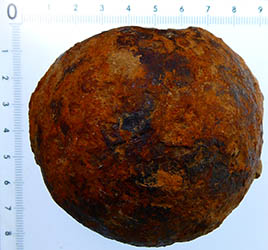 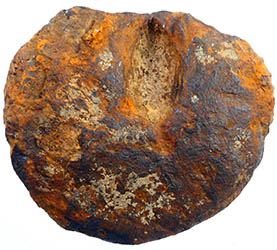 |
|
| 1640 - Civil War iron cannon ball - 57.6mm- 2.3 inches ,1.57Ibs | 17thC exploded iron cannon ball ? | |
  |
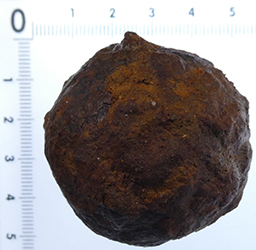 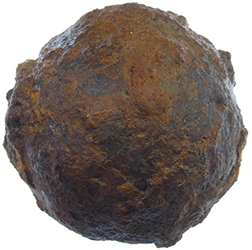 |
|
1640's Civil war iron cannon ball 1/2lb - 40mm dia - Robinet |
1640's Iron cannon ball - 2 inch | |
  |
  |
|
1640's Civil War iron cannon ball 48mm dia - 12.65oz - 3/4 Ib |
1640's Civil War cannon ball - 73.42mm (2.8inches) 1.6 Lbs, 25.6 oz |
|
 |
 |
|
1640's Civil War iron cannon ball 203g, 1/2 lb |
1640's Civil War iron cannon ball 42.4mm, 1.6 ich dia - 10oz |
|
 |
 |
|
1640's Civil War iron cannon ball 13oz, 47mm dia -1.9 inches |
1640's Civil War iron cannon ball 96g, 31mm dia, 1.2 inches |
|
 |
||
1640's Civil War iron cannon ball 30 mm, 1.2 inch dia -3.5 oz |
||
Musket balls |
 |
